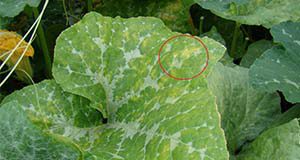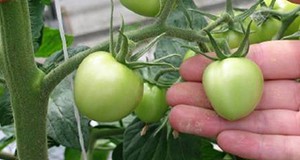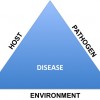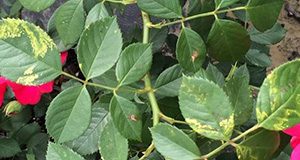Rose mosaic virus disease is one of the most economically important diseases affecting roses, because a single symptomatic leaf can result in the rejection of complete shipments for wholesale or retail rose producers. It continues to be a problem in nursery production and landscapes. This 5-page document discusses the causes, symptoms, and management of this disease. Written by Susannah da Silva, Binoy Babu, Mathews L. Paret, Gary Knox, Fanny Iriarte, Barron Riddle, Matt Orwat, Shawn T. Steed, E. Vanessa Campoverde, and Svetlana Y. Folimonova and published by the UF/IFAS Plant Pathology Department, August 2018.
http://edis.ifas.ufl.edu/pp338
Tag: Mathews L. Paret
Management of Cucurbit Downy Mildew in Florida

Cucurbit downy mildew is a major disase that affects over 40 species of cucurbits, like watermelon, muskmelon, cucumber, squash, and pumpkin. The classic sign of the disease is the presence of dark sporangia, a structure that holds developing spores, on the underside of infected leaves. As the disease progresses, it may lead to large necrotic areas that cause defoliation and a reduction of yield and marketable fruit. This nine-page fact sheet describes the symptoms and signs, epidemiology and disease cycle, host range and pathotypes, and the ways to manage cucurbit downy mildew. Written by Mason J. Newark, Mathews L. Paret, Nicholas S. Dufault, Pamela D. Roberts, Shouan Zhang, Gary E. Vallad, Josh Freeman, and Gene McAvoy, and published by the Plant Pathology Department.
http://edis.ifas.ufl.edu/pp325
“Candidatus Liberibacter solanacearum”: An Emerging Pathogen Infecting Potato and Tomato

A bacterium called “Candidatus Liberibacter solanacearum” infects potatoes and tomatoes, causing zebra chip in potatoes and psyllid yellows in tomatoes. These disease are highly destructive and have been known to reduce yields by up to 85%. “Ca. L. solanacearum” has been reported in several states, though it has not been detected in Florida, which is the second largest producer of tomatoes and seventh largest producer of potatoes in the US. This 9-page fact sheet covers the biology, distribution, symptoms, transmission, diagnosis, and management of the pathogen and its associated diseases. Written by Binoy Babu, Mathews L. Paret, Nicholas Dufault, and Carrie L. Harmon, and published by the UF Department of Plant Pathology, August 2015.
http://edis.ifas.ufl.edu/pp320
Rose Rosette Disease: A New Disease of Roses in Florida
Rose rosette disease is an incurable, destructive disease that affects both wild and cultivated roses. Over the past several decades, the disease has spread over much of the U.S., though it was first observed in Florida in 2013. This 6-page fact sheet describes the symptoms and diagnosis of the disease, as well as the cultural, chemical, and, possibly, biological controls that can minimize its spread. Written by Binoy Babu, Mathews L. Paret, Tim Schubert, Carlye Baker, Gary Knox, Fanny Iriarte, James Aldrich, Laura Ritchie, Carrie L. Harmon, and Svetlana Y. Folimonova, and published by the UF Department of Plant Pathology, May 2015.
http://edis.ifas.ufl.edu/pp317
Disease Control for Florida Tomatoes (PPP35/VH056)
 Successful disease management has always been vital in Florida tomato production, given the generally ideal environmental conditions for most plant diseases. An integrated disease management program is a successful approach. This 7-page fact sheet was written by Mathews Paret, Ken Pernezny, and Pam Roberts, and published by the UF Department of Plant Pathology, August 2013.
Successful disease management has always been vital in Florida tomato production, given the generally ideal environmental conditions for most plant diseases. An integrated disease management program is a successful approach. This 7-page fact sheet was written by Mathews Paret, Ken Pernezny, and Pam Roberts, and published by the UF Department of Plant Pathology, August 2013.
http://edis.ifas.ufl.edu/vh056
Integrated Disease Management for Vegetable Crops in Florida (PP193/PP111)
 Integrated Pest Management (IPM) as applied to vegetable diseases means using all the tactics available to the grower (cultural, biological, host-plant resistance, field scouting, chemical) that provide acceptable yield and quality at the least cost and are compatible with the tenets of environmental stewardship. This 6-page fact sheet was written by Mathews Paret, Nick Dufault, Tim Momol, Jim Marois, and Steve Olson, and published by the UF Department of Plant Pathology, August 2012.
Integrated Pest Management (IPM) as applied to vegetable diseases means using all the tactics available to the grower (cultural, biological, host-plant resistance, field scouting, chemical) that provide acceptable yield and quality at the least cost and are compatible with the tenets of environmental stewardship. This 6-page fact sheet was written by Mathews Paret, Nick Dufault, Tim Momol, Jim Marois, and Steve Olson, and published by the UF Department of Plant Pathology, August 2012.
http://edis.ifas.ufl.edu/pp111
Rose Pests and Diseases in Florida (ENH1108/EP371)
 Roses are one of the most popular flowering shrubs in Florida and the United States. Valued for their beautiful and often fragrant blooms, roses have been cultivated in gardens for centuries as vines. Roses can grow and flower 9 months of the year in North Florida and year-round in the rest of Florida. Roses have become especially popular in recent years with the introduction of Knock Out® and other shrub roses. Unfortunately, increased use and misuse of roses have resulted in more reports of pest problems. This 9-page fact sheet was written by Gary W. Knox, Mathews Paret, and Russell F. Mizell, III, and published by the UF Department of Environmental Horticulture, January 2012.
Roses are one of the most popular flowering shrubs in Florida and the United States. Valued for their beautiful and often fragrant blooms, roses have been cultivated in gardens for centuries as vines. Roses can grow and flower 9 months of the year in North Florida and year-round in the rest of Florida. Roses have become especially popular in recent years with the introduction of Knock Out® and other shrub roses. Unfortunately, increased use and misuse of roses have resulted in more reports of pest problems. This 9-page fact sheet was written by Gary W. Knox, Mathews Paret, and Russell F. Mizell, III, and published by the UF Department of Environmental Horticulture, January 2012.
http://edis.ifas.ufl.edu/ep371
Managing Thrips and Tospoviruses in Tomato (ENY859/IN895)
 Several invasive species of thrips have established in Florida and are causing serious economic losses to vegetable, ornamental, and agronomic crops. Damage to crops results from thrips feeding and egg-laying injury, by the thrips vectoring of plant diseases, the cost of using control tactics, and the loss of pesticides due to resistance. This 12-page fact sheet describes the biology and ecology of thrips and tomato spotted wilt virus, and recommends a management program. Written by Joe Funderburk, Stuart Reitz, Steve Olson, Phil Stansly, Hugh Smith, Gene McAvoy, Ozan Demirozer, Crystal Snodgrass, Mathews Paret, and Norm Leppla, and published by the UF Department of Entomology and Nematology, August 2011.
Several invasive species of thrips have established in Florida and are causing serious economic losses to vegetable, ornamental, and agronomic crops. Damage to crops results from thrips feeding and egg-laying injury, by the thrips vectoring of plant diseases, the cost of using control tactics, and the loss of pesticides due to resistance. This 12-page fact sheet describes the biology and ecology of thrips and tomato spotted wilt virus, and recommends a management program. Written by Joe Funderburk, Stuart Reitz, Steve Olson, Phil Stansly, Hugh Smith, Gene McAvoy, Ozan Demirozer, Crystal Snodgrass, Mathews Paret, and Norm Leppla, and published by the UF Department of Entomology and Nematology, August 2011.
http://edis.ifas.ufl.edu/in895
2011 Florida Plant Disease Management Guide: Apple (Malus domestica) (PDMGV305/PG004)

This updated 13-page fact sheet from the 2011 Florida Plant Disease Management Guide highlights several common diseases affecting apples in Florida and includes short list of fungicides approved for disease management of apple in Florida. Written by Mathews L. Paret, Tim Momol, Laura Ritchie, and Hank Dankers, and published by the UF Department of Plant Pathology, July 2011. (photo courtesy of Clemson University – USDA Cooperative Extension Slide Series, Bugwood.org)
http://edis.ifas.ufl.edu/pg004
Management of Gummy Stem Blight (Black Rot) in Cucurbits in Florida (PP280)
Gummy stem blight (GSB) is a major disease of many cucurbits, including watermelon, cantaloupe, cucumber, pumpkin, squash, muskmelon, and other melons. The disease is also known as black rot due to its characteristic appearance on infected fruits. Learn the symptoms, causal agent and disease spread, and fungicides labeled for use in Florida. This 9-page fact sheet was written by Mathews L. Paret, Nicholas S. Dufault, and Stephen M. Olson , and published by the UF Department of Plant Pathology, January 2011.
http://edis.ifas.ufl.edu/pp280
PP276 Integrated Management of White Mold on Vegetables in Florida
PP276, a 10-page illustrated fact sheet by Mathews L. Paret and Stephen M. Olson, provides information on what crops white mold (Sclerotinia spp.) affects in Florida and available methods of control. Includes references. Published by the UF Department of Plant Pathology, July 2010.
http://edis.ifas.ufl.edu/pp276

